
"*" indicates required fields
"*" indicates required fields
"*" indicates required fields

Overall, market conditions remain loose despite some seasonal tightness in certain regions. Declining freight demand coupled with abundant capacity is keeping spot rates low, resulting in margin compression for carriers. We expect short-lived volatility over the next month in line with typical seasonality, after which we will likely return to current conditions.
Demand continued to slow in October, as expected. Early November numbers indicate that increased demand volatility is likely as we approach the holidays.
The reefer market is starting to see the impact of a holiday push, with certain regions experiencing rapidly tightening conditions.
Van tender rejection rates remain below 4%, illustrating historically strong contract compliance and carriers’ continued appetite for accepting nearly all contract freight.
Reefer tender rejection rates are approaching 9%, indicating that the reefer market is particularly vulnerable to major disruptions.
The spot-contract gap for van and reefer freight fell to $0.45 and $0.42 per mile, respectively, as low spot rates apply more downward pressure on contract rates.
Record-high revocations continue as carriers with heavy spot market exposure struggle to keep up with elevated operating costs.
2024 Class 8 truck orders continue to come in, indicating that a healthy number of carriers remain profitable enough to invest in their fleets despite the state of the market.
Class 8 backlogs are leveling out as 2024 build slots open and orders pile up.
Carriers with heavy spot exposure continue to leave the market due to ongoing margin compression.
Carriers with contractual freight are relatively stable, adding drivers and investing in new equipment.
Import volumes remain up year-over-year, indicating a return to seasonal patterns; volumes will likely stay in line with 2022 levels for the foreseeable future.
Inflation continues to cool but remains elevated; the Fed appears unlikely to lower interest rates anytime soon.
What’s Happening: Market conditions remain relatively loose, but tight pockets are emerging in line with typical seasonality.
Why It Matters: Certain regions are seeing rate volatility, something we have not seen much of this year.
The Morgan Stanley Dry Van Freight Index measures relative supply; the higher the index, the tighter the market conditions. The black line with triangle markers on the chart provides a great view of what directional trends would be in line with normal seasonality based on historical data dating back to 2007.
According to the index, October conditions eased in line with historical seasonal patterns, indicating supply is still largely sufficient to support demand. Historical data points to potential tightening from now through the end of the year as seasonal demand picks up in the weeks leading up to Thanksgiving.
Figure 1: Morgan Stanley Dry Van Truckload Freight Index

In October, Arrive launched a new survey designed to help our team better understand the carrier experience in today’s market. The questions gauged carriers’ sentiment on various economic indicators and asked for their predictions on how the next 90 days will unfold. When questioned about the state of the market, over 50% of respondents reported that current conditions are relatively loose, and 25% said they are tight or very tight.
Those results changed when looking 90 days down the road — the consensus was market conditions would either look much like they do today or slightly tighter. 40% of respondents believe conditions will still be loose, and over a quarter say we will be experiencing intermediate conditions. 21% of respondents believe we will be in a tight market, while 12% expect very tight conditions.
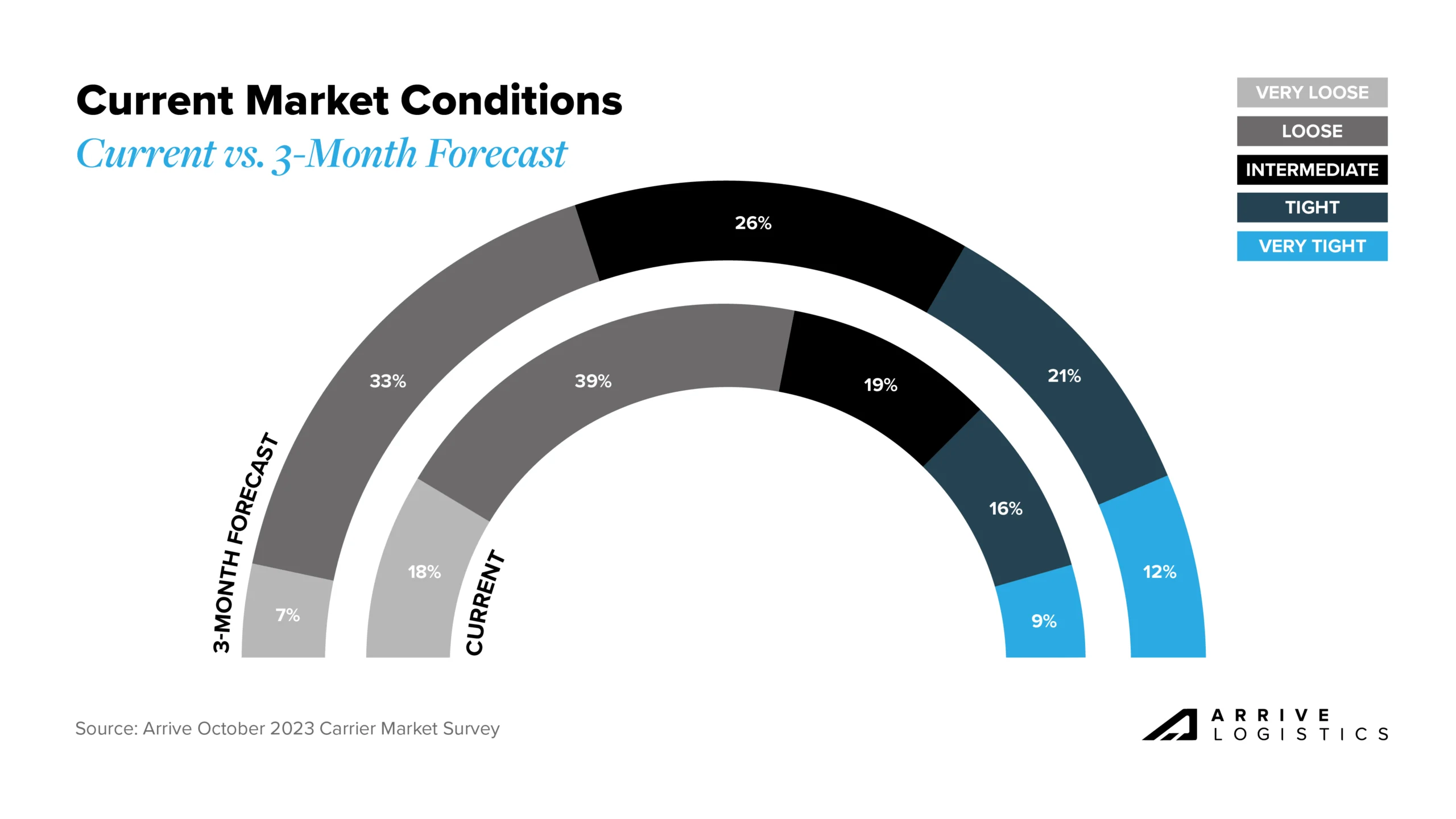
According to ACT’s Supply-Demand Index, market conditions tightened in back-to-back months following 17 consecutive months of loosening. The index dropped slightly from 55.6 in August to 52.8 in the most recent reading due to steady freight demand and capacity exits. It’s important to note that this is merely a directional measurement, and the market remains soft overall.
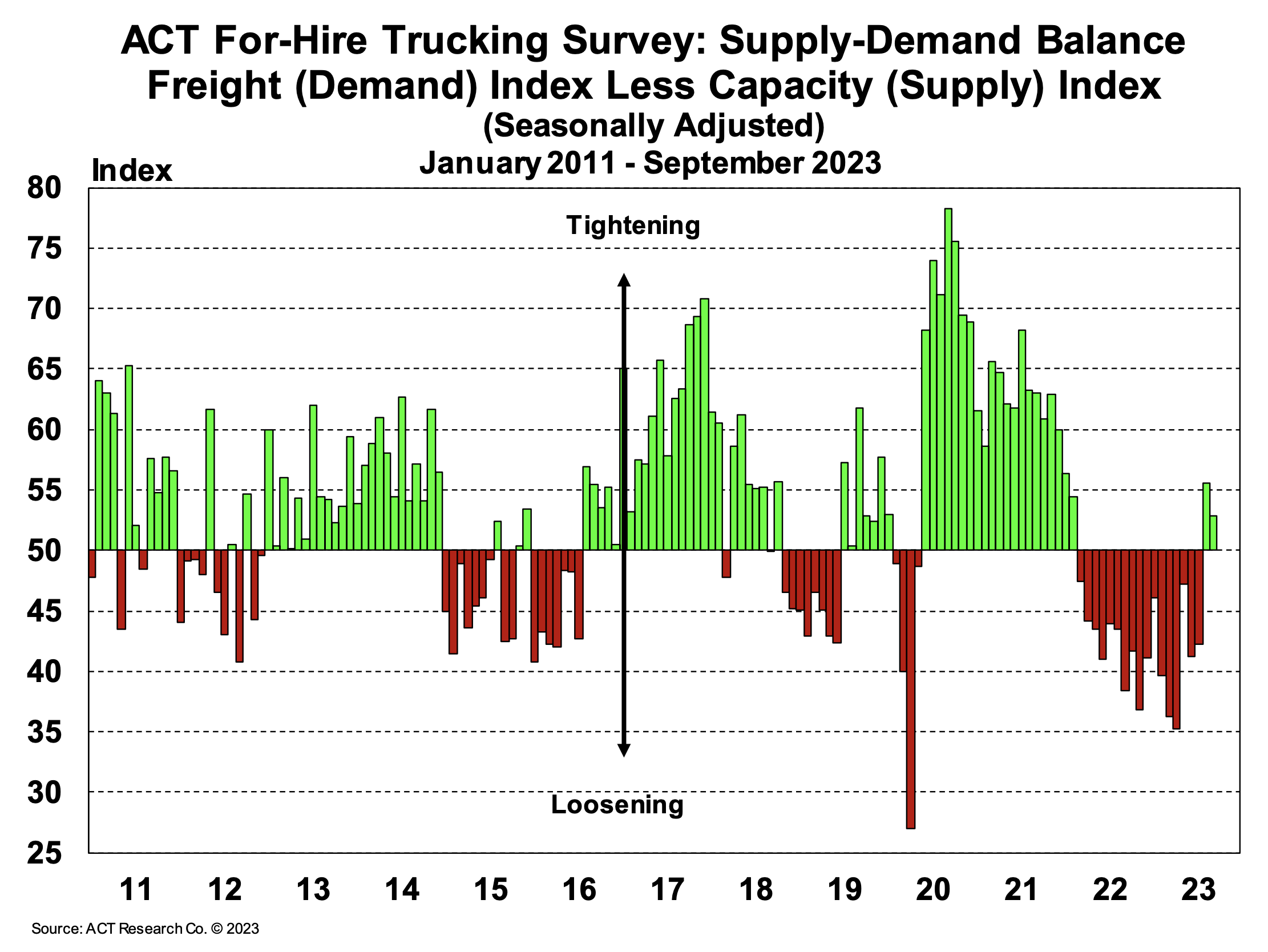
The risk of capacity challenges materializing is increasing as Q4 continues. Reefer equipment is already getting tight in mid-November, and dry van tightening is likely to follow soon.
Overall, capacity remains sufficient to support current demand, but seasonal surges are causing regional tender rejection spikes. Similar spikes during the summer peak led to pockets of rate volatility, so we expect this trend to continue through at least year-end.
The Sonar Outbound Tender Reject Index (OTRI) measures the rate at which carriers reject the freight they are contractually required to take. The numbers fluctuated between a high of 3.85% early in the month and a low of 3.46% by month-end, indicating routing guide compliance on shippers’ contractual freight improved further from historically high levels.
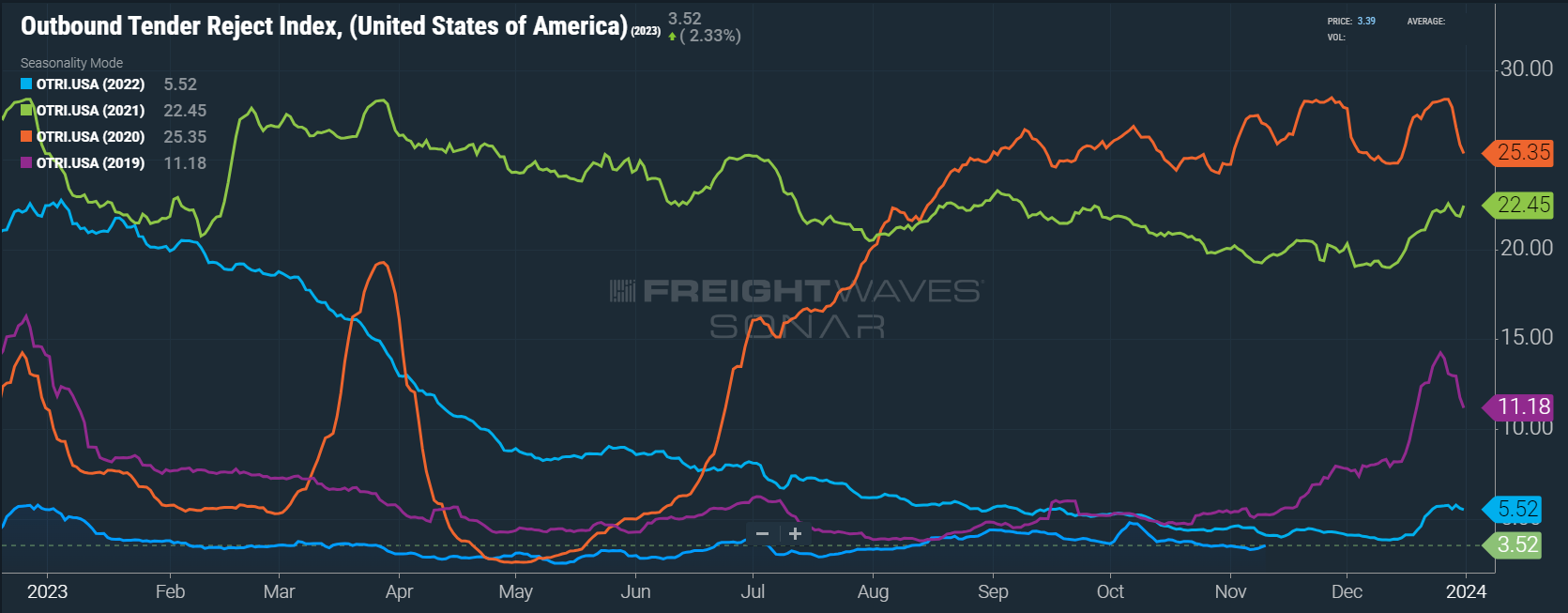
Tender rejections followed a similar pattern for reefer equipment in October but have spiked during the last week from 6% to nearly 9% (and climbing). As early as September, we stated our expectations for reefer equipment challenges ahead of Thanksgiving and Christmas. The volatility associated with the summer peak season was a strong leading indicator that this would happen again in Q4 due to seasonal food demand surges.

According to Sonar’s Contract Load Accepted Volume Index (CLAV), contract volumes rose steadily in the back half of October and into November but have since settled. This dip is in line with historical norms. The index will likely rise before Thanksgiving, then steadily decline throughout December. The index value for the remainder of 2023 should remain relatively close to what it was in December 2022.
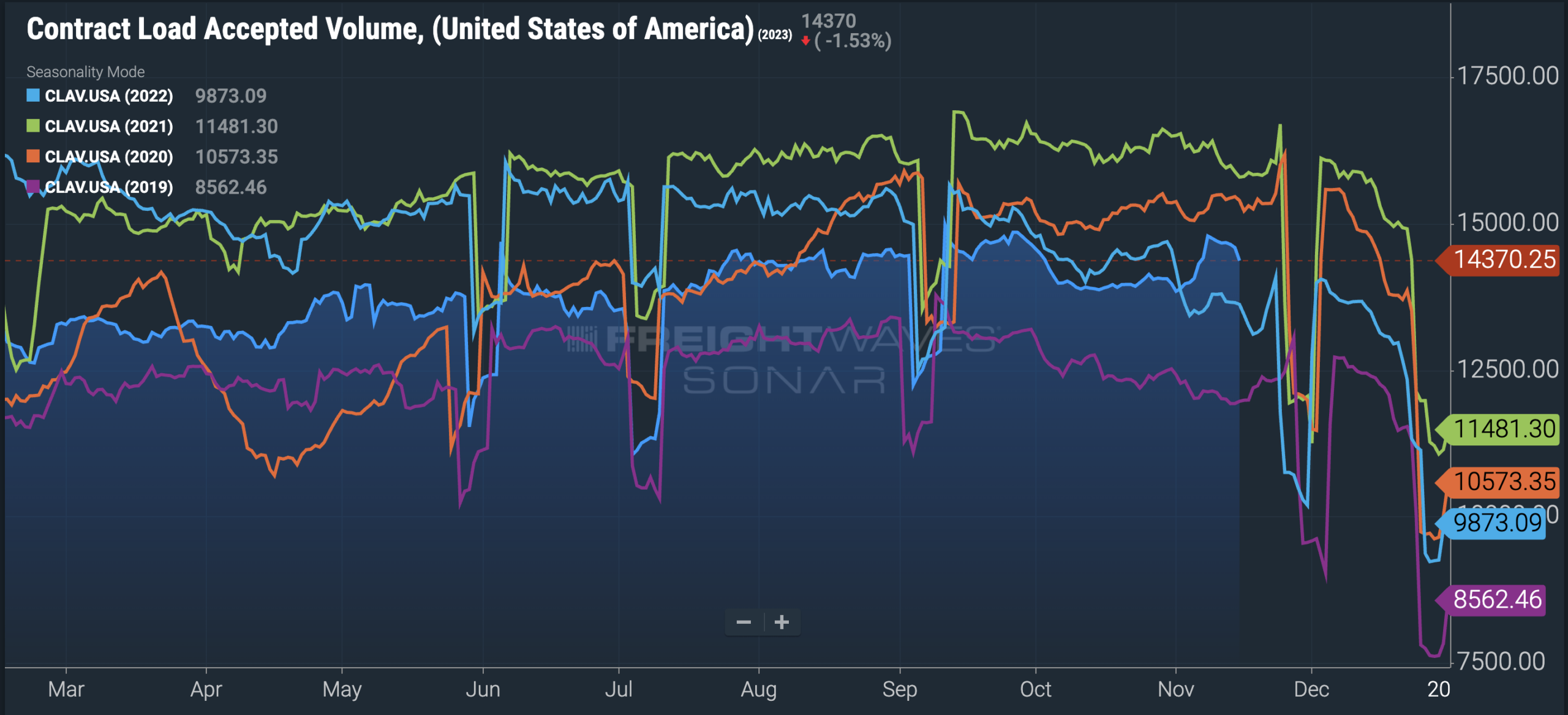
The DAT Load-to-Truck Ratio measures the total number of loads relative to the total number of trucks posted on their spot board. With declining load posts and increasing truck posts, the October reading fell to the lowest point since April.
The Dry Van Load-to-Truck Ratio was down 24.2% month-over-month and remains down 27.6% year-over-year, whereas the Reefer Load-to-Truck Ratio was down 14% month-over-month and 42.3% year-over-year. It’s worth noting that the Reefer Load-to-Truck Ratio was up 26% in the first week of November compared to the last week of October, validating trends seen in other reefer indices.
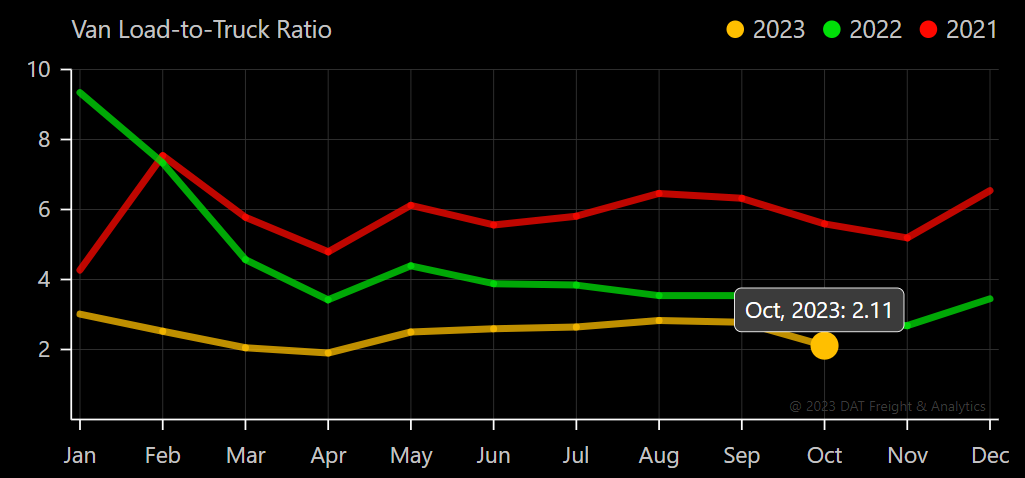
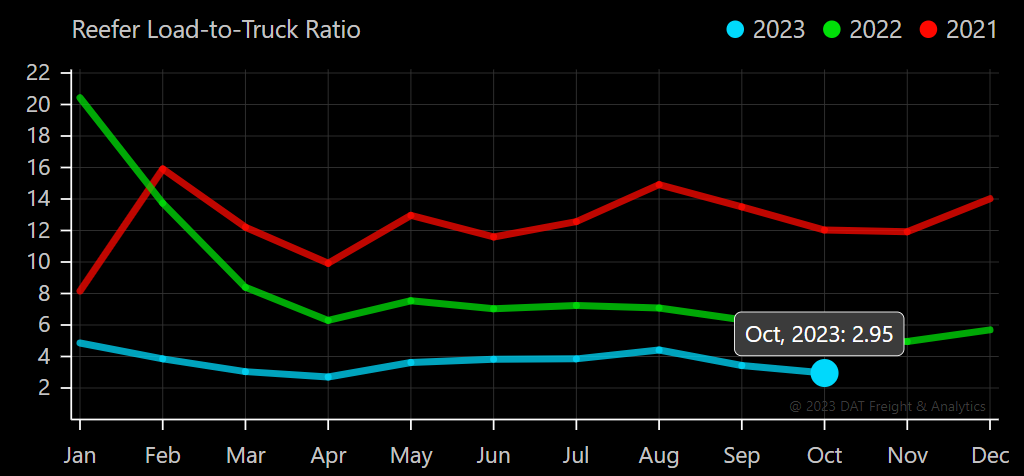
What’s Happening: Capacity continues to exit the market at high rates.
Why It Matters: Significantly more capacity will need to leave the market to trigger inflationary conditions.
Monthly revocations jumped meaningfully in October and remain highly elevated compared to historical norms. This month, significant revocations again led to a negative net change in the carrier population. Strong contract service numbers indicate the market correction is far from over, but this trend will inevitably lead to a capacity crunch, as it always does in the market cycle.
Increased operating expenses are the primary culprit causing carriers to close, as overall rates are still high compared to pre-pandemic levels. This trend continues to drive record revocations of authority, with October totals reaching their highest point since May at just over 7,400 carriers.
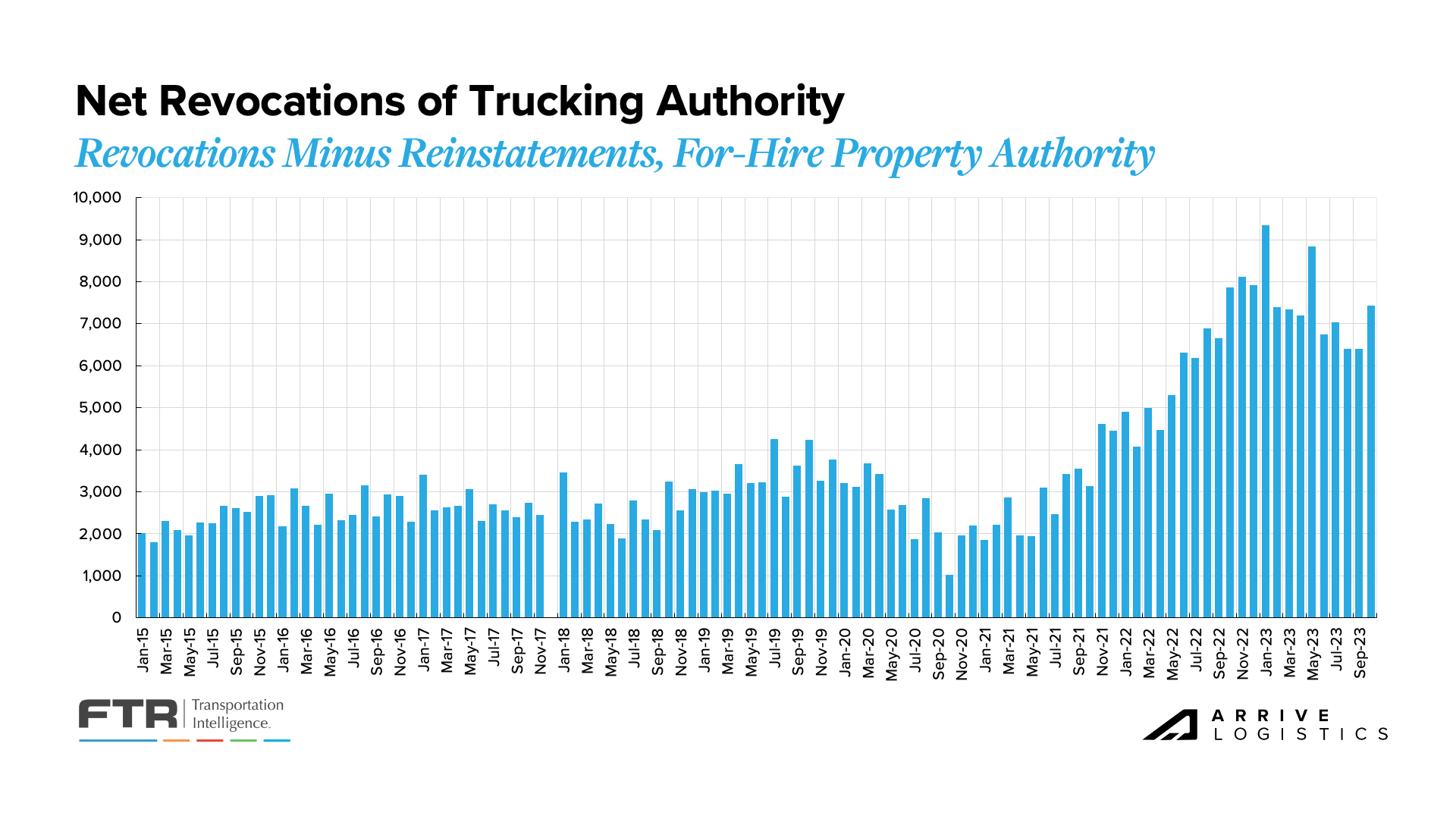
A key trend we’re still watching is revocations outpacing new carriers entering the market for 12 of the last 13 months, reducing the total number of carriers. Large numbers of drivers entered the market when there was money to be made in the spot market, so balance must be restored before conditions can improve for carriers. With the market still clearly oversupplied, we expect revocations to outpace new entrants for the foreseeable future.
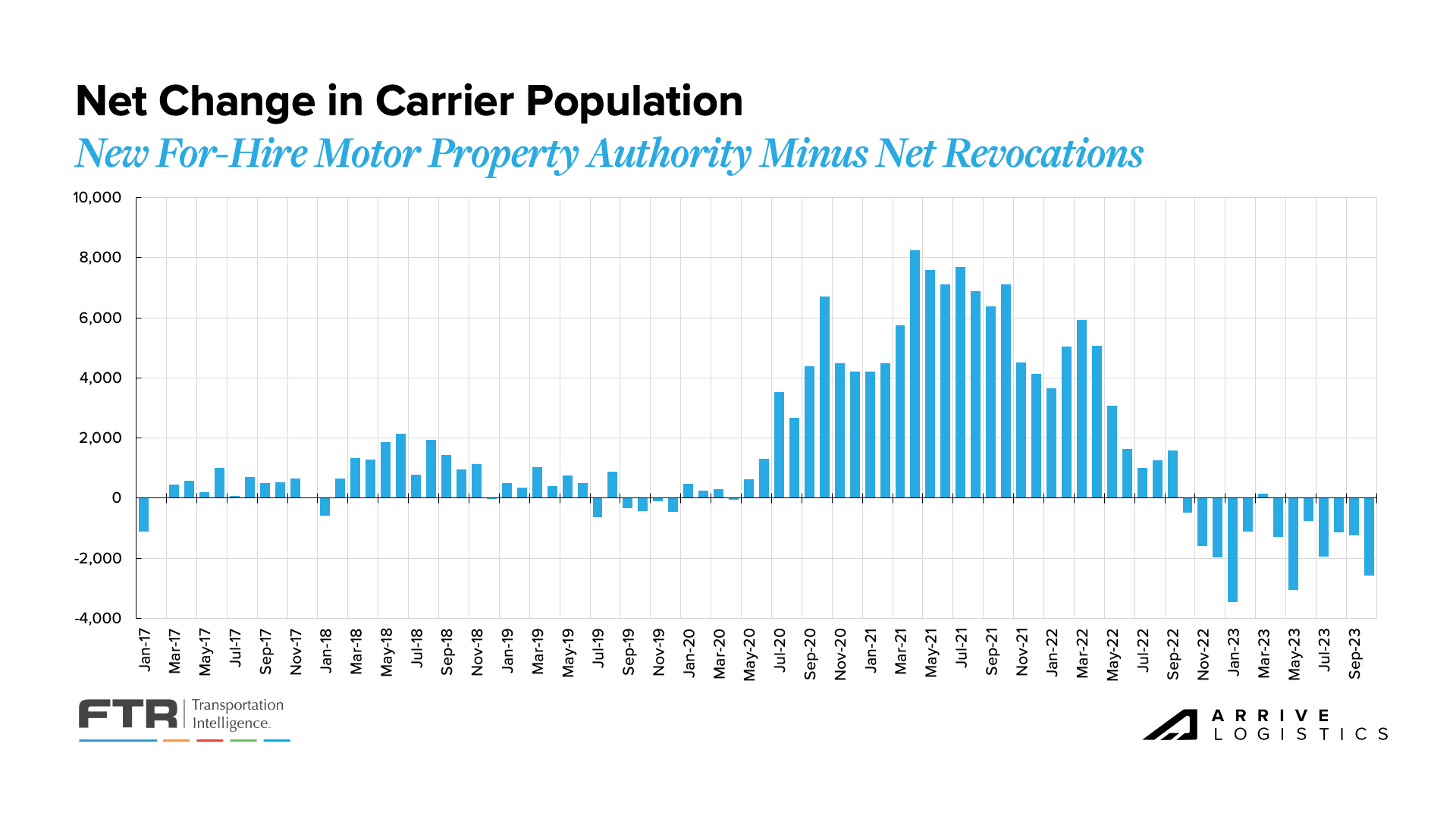
New equipment orders typically slow during freight recessions, making the recent spike more intriguing. As OEMs opened up 2024 build slots, carriers quickly secured new orders. While that trend could be caused by California-based asset carriers making a run on diesel trucks before they are required to convert their fleets to alternative fuels, these investments also point to the financial strength of larger carriers and private fleets and, in turn, the possibility of a much slower capacity correction than in previous cycles. Overall, freight demand is healthy, so larger fleets are adding capacity to insource volume back from smaller for-hire fleets and owner-operators.
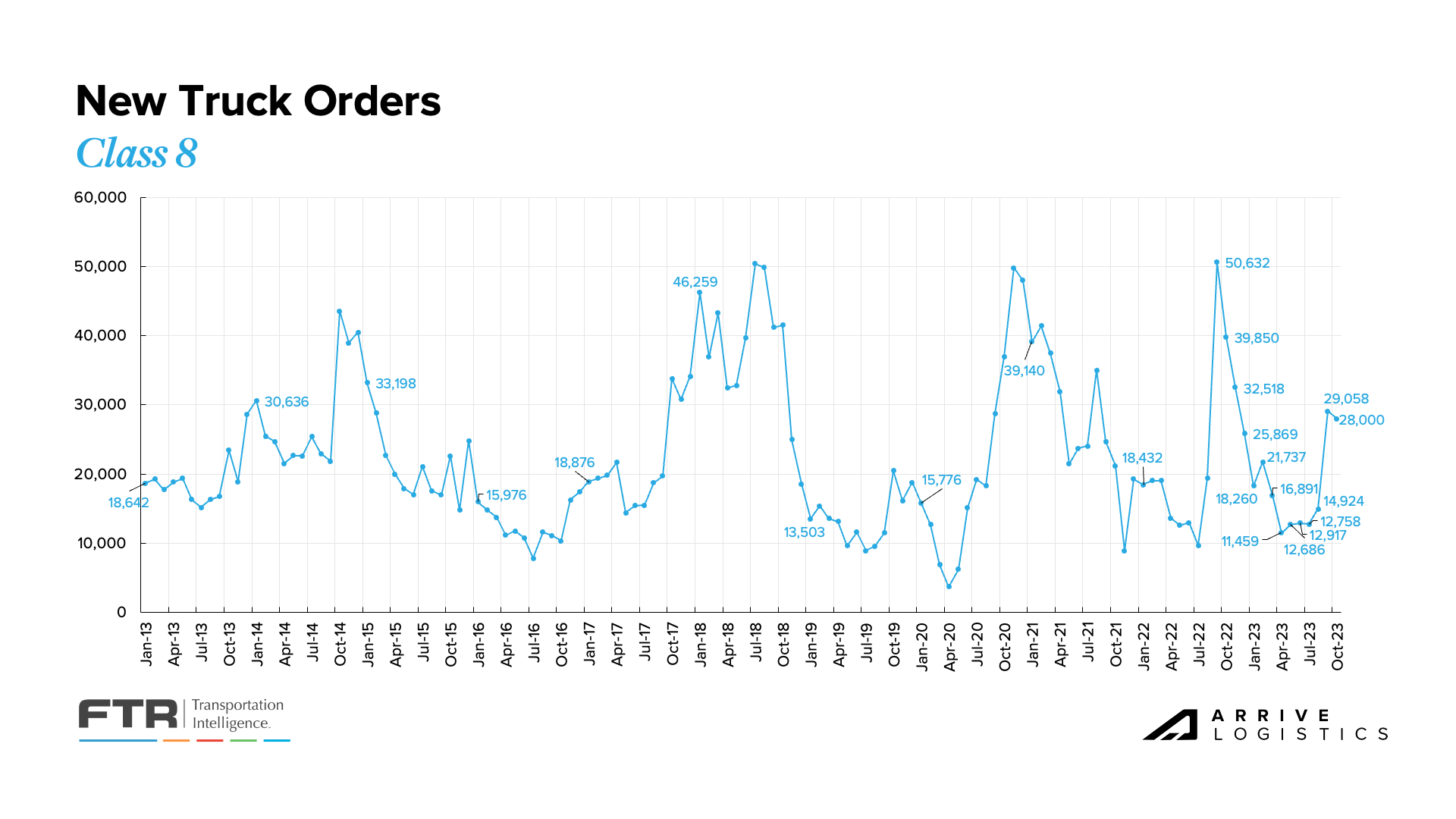
The October Class 8 Backlog/Build ratio rose to 5.5 months from 5.1 months in September. The backlog steadily declined all year before increasing by 2,250 units in September. As carriers claim more 2024 build slots in the coming months, backlogs will likely remain relatively flat and new truck orders will be a key trend to watch.
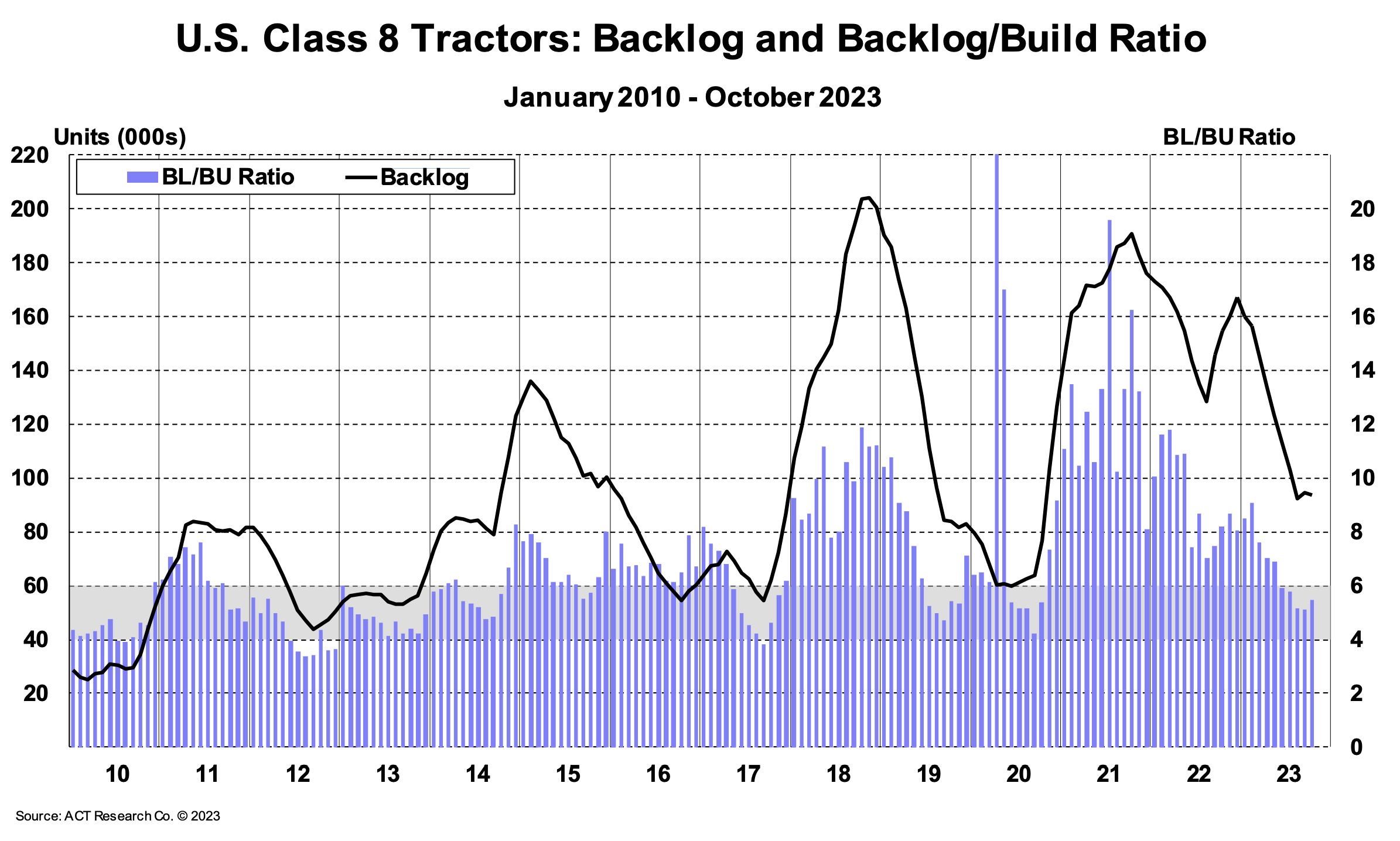
ACT’s Driver Availability Index hit an all-time high of 62 in September, marking 16th consecutive months of loosening driver conditions. It’s believed that the primary driver of this trend is the influx of owner-operators joining larger fleets that have historically struggled with driver retention. Overarching challenges, such as the retirement rate of drivers and FMCSA drug clearance, remain prevalent.
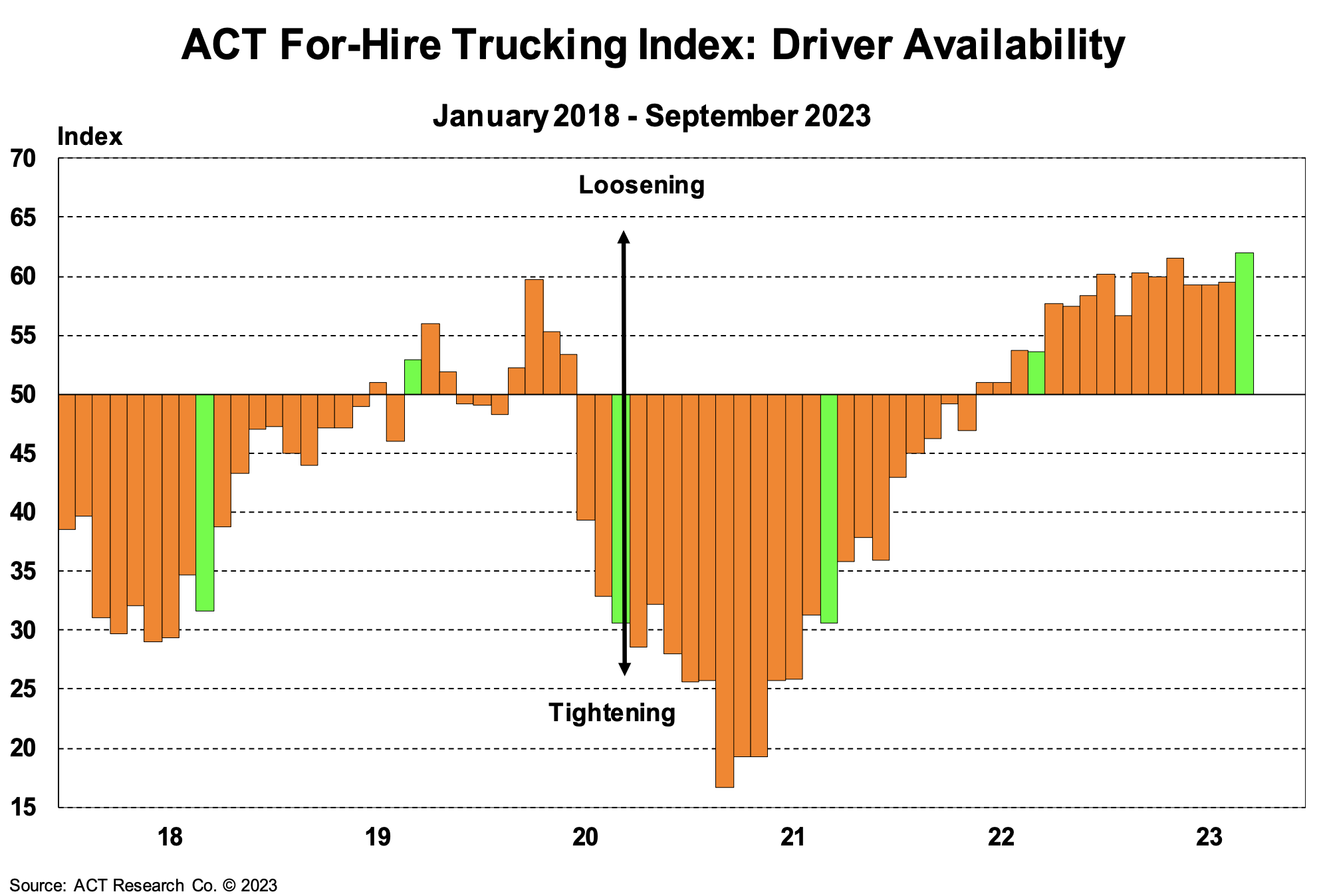
Our October survey asked carriers their opinion on the current truckload supply and what they believe it will be like in three months. 58% of respondents said that supply today is relatively balanced,16% said it is plentiful and 30% said it’s limited. As for the three-month projections, a few more carriers said capacity will be plentiful compared to now — this is relatively in line with our expectations.
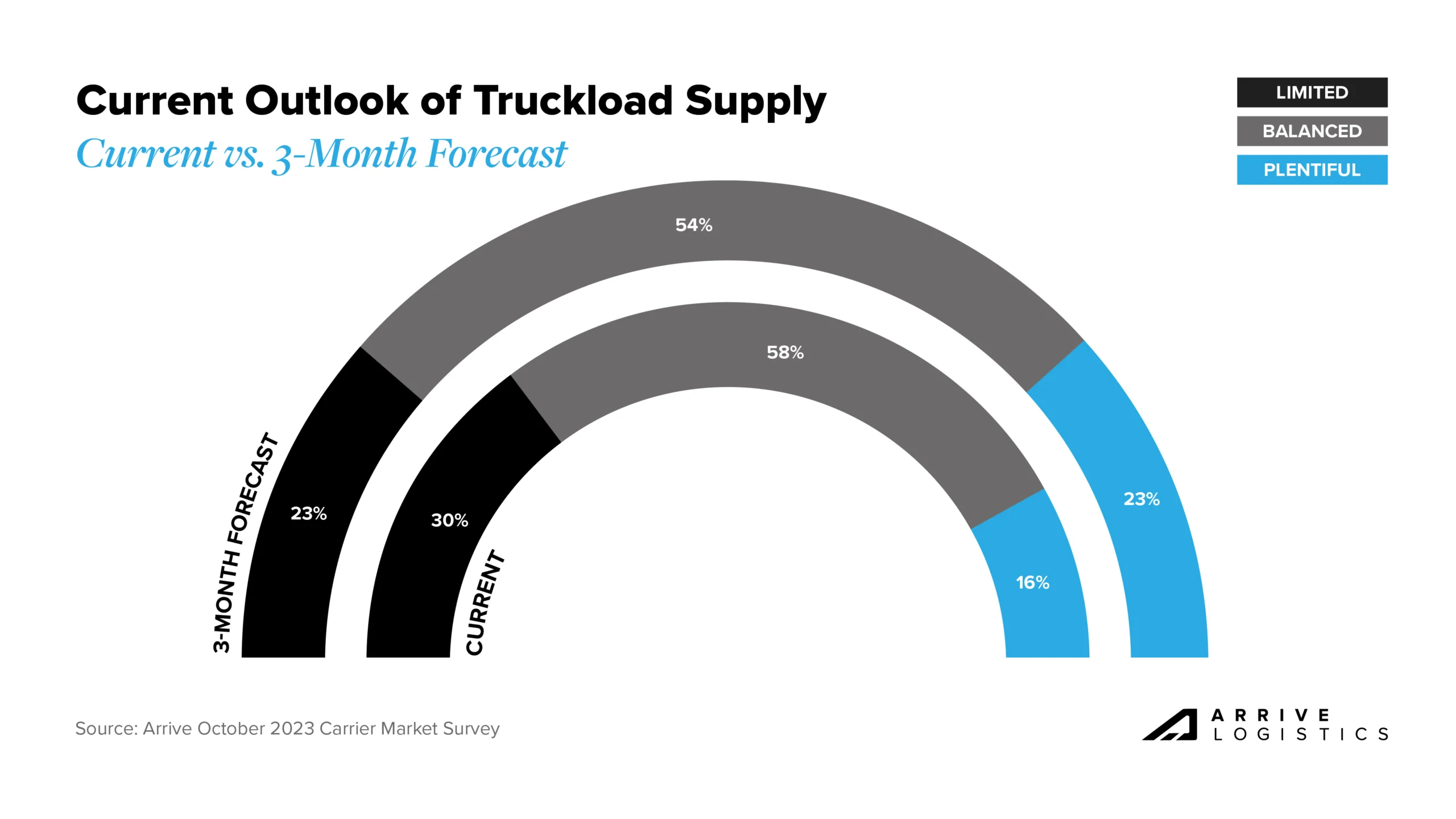
What’s Happening: Overall freight demand remains down as economic uncertainty persists.
Why It Matters: With demand trends forecasted to remain steady in the near future, any meaningful rate increases are unlikely.
The survey also prompted carriers about current and future truckload demand. 47% of respondents said demand today is neutral, 32% reported weak demand and 21% said demand is strong.
In their three-month forecasts, more than half (56%) of all respondents expect balanced conditions and 26% expect strong demand. This aligns with our forecast that demand will increase through Q4, albeit muted compared to the past few years.
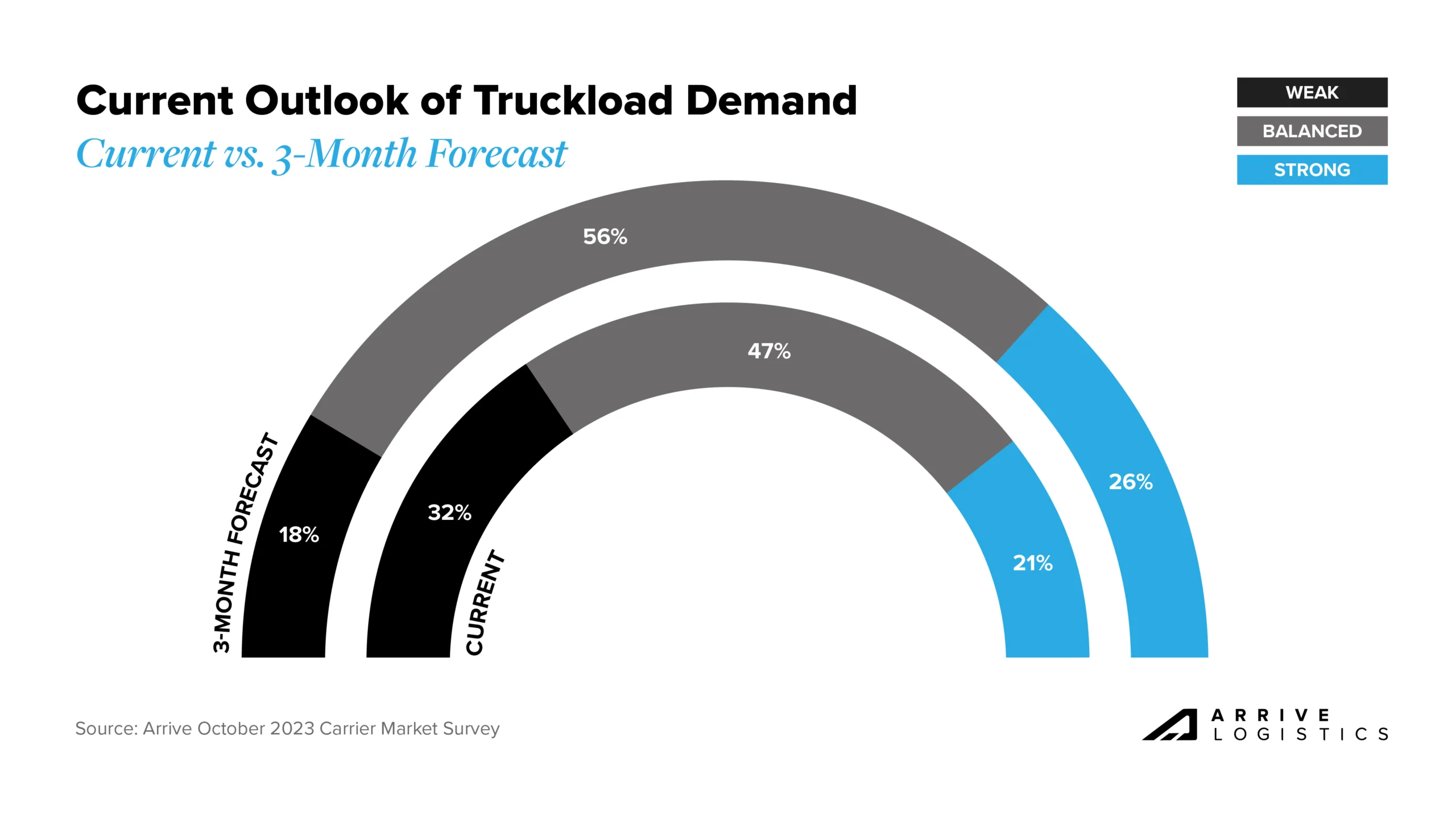
The National Retail Federation (NRF) recently said that retailers expect record-setting sales this holiday season and have their shelves stocked to meet demand, whether in stores or at distribution centers fulfilling online orders.
The fact that inventories are already in position should result in limited demand surges. Still, last-minute challenges are hard to avoid, particularly if American consumers show up as expected. Retail imports should also wind down as the year progresses. However, if retail inventories are depleted heading into 2024, a return to typical restocking trends is likely and could increase demand.
If import volumes trend as expected through Q4, the 13.5% year-over-year decline in July could flip to a nearly 7% increase in year-over-year import growth by December. This gives some context to how the inventory cycle’s reset could impact demand and just how large a step back retailers took a year ago to correct their overstocked inventories.
Figure 19: NRF Monthly Imports
Truckload demand has been relatively lackluster in the first half of Q4. However, this lull between the end of Q3 and the holiday peak season ramp-up is not unusual by seasonal standards.
In mid-November, most signs indicate reefer equipment will be challenging through the year-end as demand associated with holiday meals sets in. Van freight has been free from significant disruptions thus far, and with most holiday retail inventory already in place, capacity challenges are expected to be limited to the weeks leading up to and following Christmas.
The DAT reports exclusively on spot load trends and noted that posts were down for the second straight month, falling 7.1% from September to October after decreasing 12.3% from August to September. Annual comps still showed a year-over-year decline, with spot load posts improving slightly from -43.4% in September to -41.6% in October.
Of additional note, spot load posts were up 9.5% from the last week of October to the first week of November, highlighting the growing risk of volatility to seasonal demand as the quarter progresses.
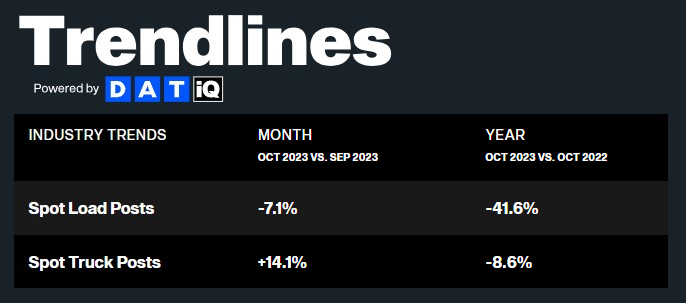
What’s Happening: Carriers with heavy spot exposure continue to feel margin compression and exit the market.
Why It Matters: As capacity decreases, market conditions will move towards equilibrium.
Spot rates continue to stabilize but remain well below operating costs for public carriers, which reported negative margins on spot loads for the third consecutive quarter. This trend will likely affect owner-operators and carriers with high spot exposure, potentially leading them to close or join larger fleets. Historically, there would be a rapid rise in spot rates when this occurs. However, capacity is still plentiful, indicating that conditions could remain rough in the near term.
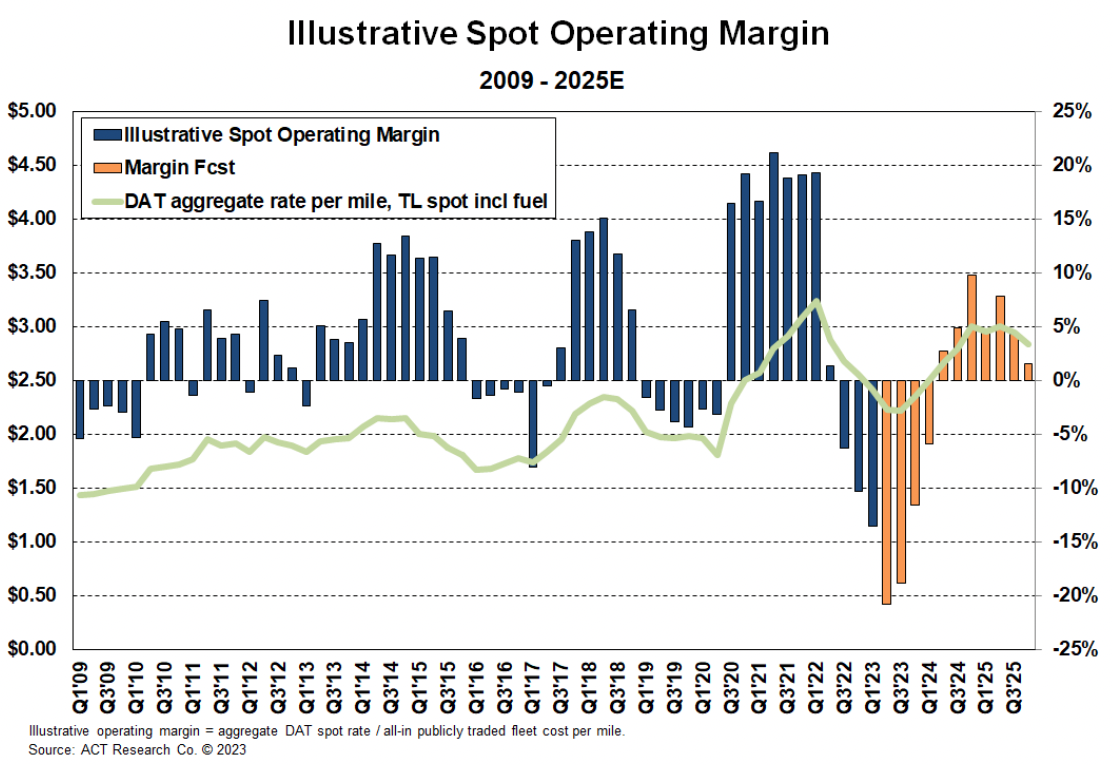
Carriers continue to experience margin compression as spot rates remain low amid high operating expenses. Net income margins in Q3 2023 remained below 5%. Q3 was also the fifth straight quarter where carriers had declining year-over-year margins. As we move through this oversupplied market, conditions will likely stay challenging in the near term and into early 2024.
Figure 22: ACT TL Carrier Database, Net Income Margin, Core Carriers
According to financial data from large public carriers, operating revenue per mile has continued to fall faster than the cost per mile, decreasing operational margins to pre-pandemic levels. Despite the sizeable margin decline, large asset carriers are still in a relatively healthy financial position due to having enough contract freight to limit spot market exposure. On the flip side, owner-operators and smaller fleets are seeing more margin compression and closing or joining larger fleets to stay on the road.
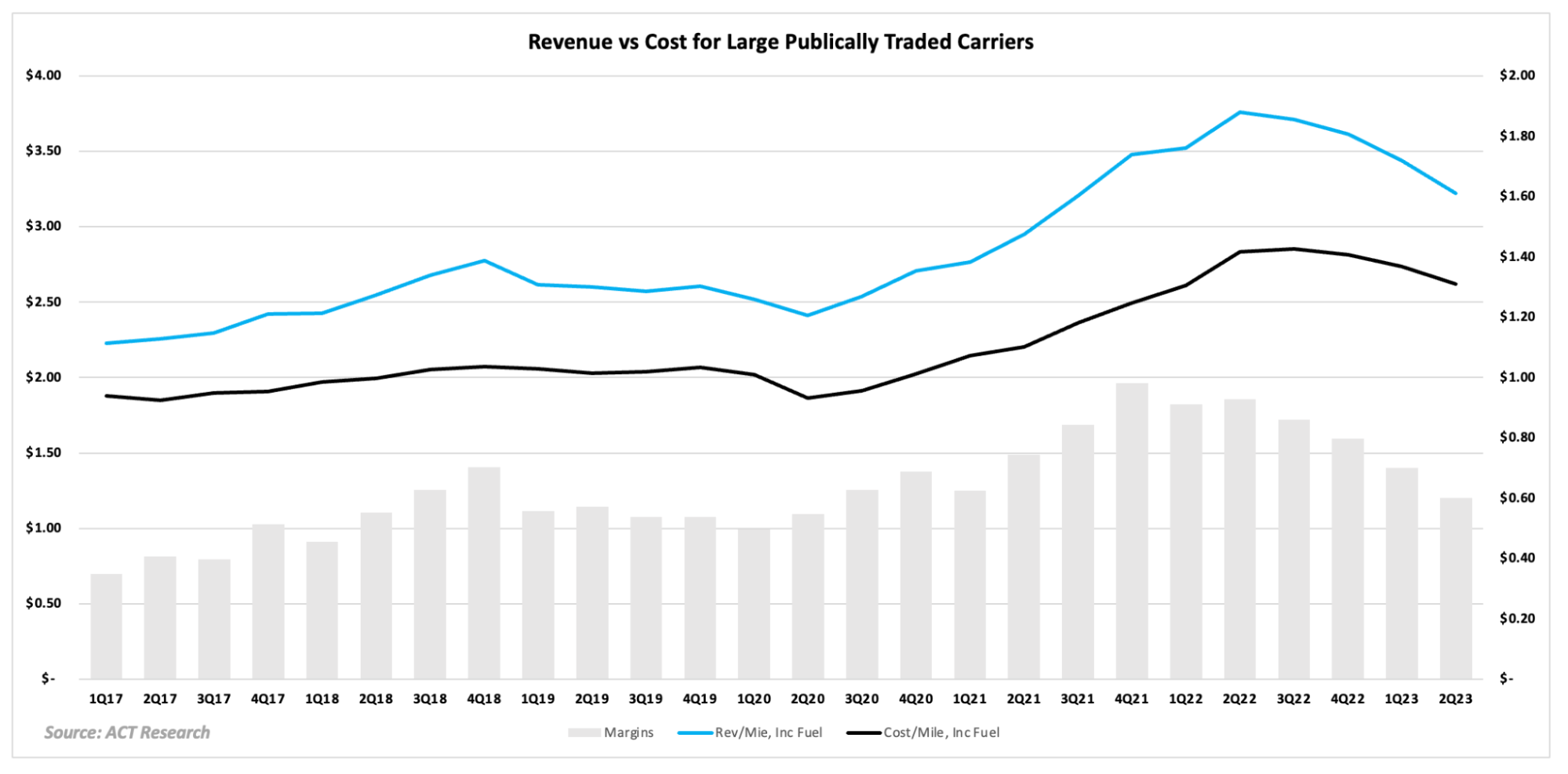
Looking at driver availability survey results, 18% of respondents reported limited driver availability, over half said it was balanced, and nearly a third said it is plentiful today and will still be three months from now. These results confirm our perspective that the market is still oversupplied and indicate carriers believe current conditions will hold for the short-medium term because drivers with access to contract freight remain healthy, and larger fleets continue to take on capacity from smaller fleets and owner-operators.
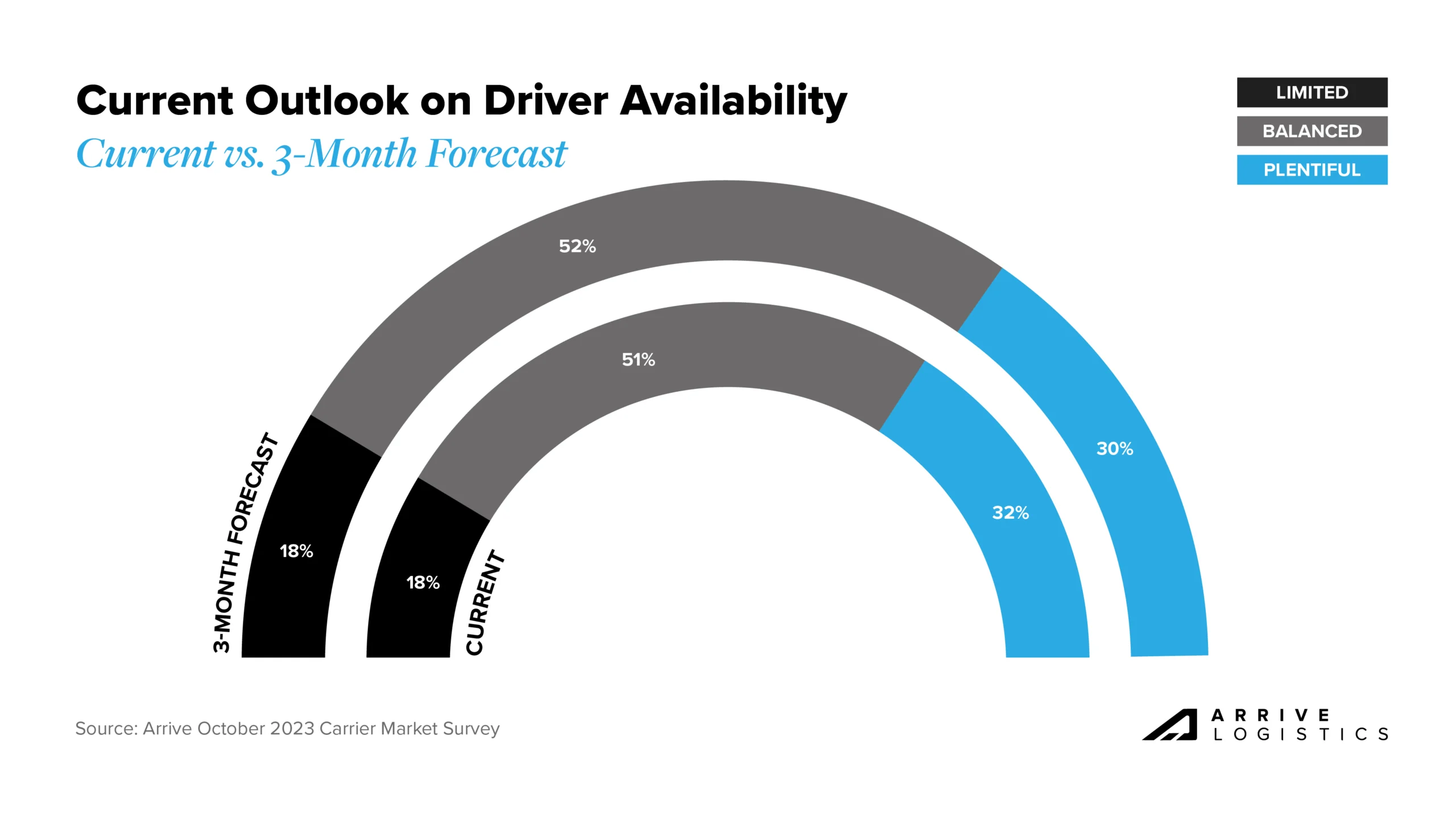
What’s Happening: Limited backhaul opportunities are driving up Canadian freight rates inbound to the U.S.
Why It Matters: Shippers could pay a premium as capacity tightens in peak season.
What’s Happening: The market is stable heading into the holidays.
Why It Matters: Though significant disruption is unlikely, some volatility is possible as peak season ramps up.
What’s Happening: The market remains resilient following Yellow’s bankruptcy.
Why It Matters: Shippers relying on LTL are breathing a sigh of relief as rates hold mostly steady.
What’s Happening: PNW demand is heating up.
Why It Matters: Potatoes, onions and Christmas trees are driving tightness in the region.
Overall Trends
Temp control demand continues to follow typical seasonality, with tightness increasing in certain regions.
Demand for protect-from-freeze freight could increase as the winter months begin.
Temp-control volatility could increase in Canada as winter storms roll in.
East Coast
Tightness is increasing in Eastern Pennsylvania and Upstate New York as apples, potatoes and dairy move in the region.
The Carolinas and Virginia have softened significantly along with the rest of the Southeast; the region will remain relatively loose until spring.
Upper Midwest
Central Plains
Southwest
Pacific Northwest
What’s Happening: Capacity is more than sufficient to support demand.
Why It Matters: Significant disruption is unlikely until 2024.
What’s Happening: Dry van rates have found a floor while reefer sees spikes.
Why It Matters: Rate trends illustrating steady market conditions before the end-of-year push.
The Truckstop’s Weekly National Average Spot Rates index provides a detailed view of week-to-week rate movements and a real-time look into the current rate environment.
While dry van rates appear to have found a firm floor, recent data points to a spike in reefer rates following a seven-week slide from $2.55 to $2.31 per mile, excluding fuel. These rate trends largely match what we have seen in tender rejection and load-to-truck data; however, though conditions softened further in October, rates did not move much lower, a sign that nationwide rates are unlikely to fall from current levels moving forward, even as seasonal demand ebbs and flows.
Figure 25: Truckstop Weekly National Average Spot Rates
The month-over-month van rate spread decreased slightly from $0.48 in October to $0.45 month-to-date in November, the lowest reading since deflationary conditions set in during March 2022. Driving the gap’s closure was a $0.06 decline in all-in contract rates or $0.04 when excluding fuel.
All-in dry van spot rates are down 13.4% year-over-year in November, while linehaul spot rates are down 9.9%, the lowest negative growth rate since April 2022. All-in dry van contract rates are down 17.4% year-over-year, and linehaul contract rates are down 16.0%. These improvements continue to illustrate that peak deflationary pressures are behind us.
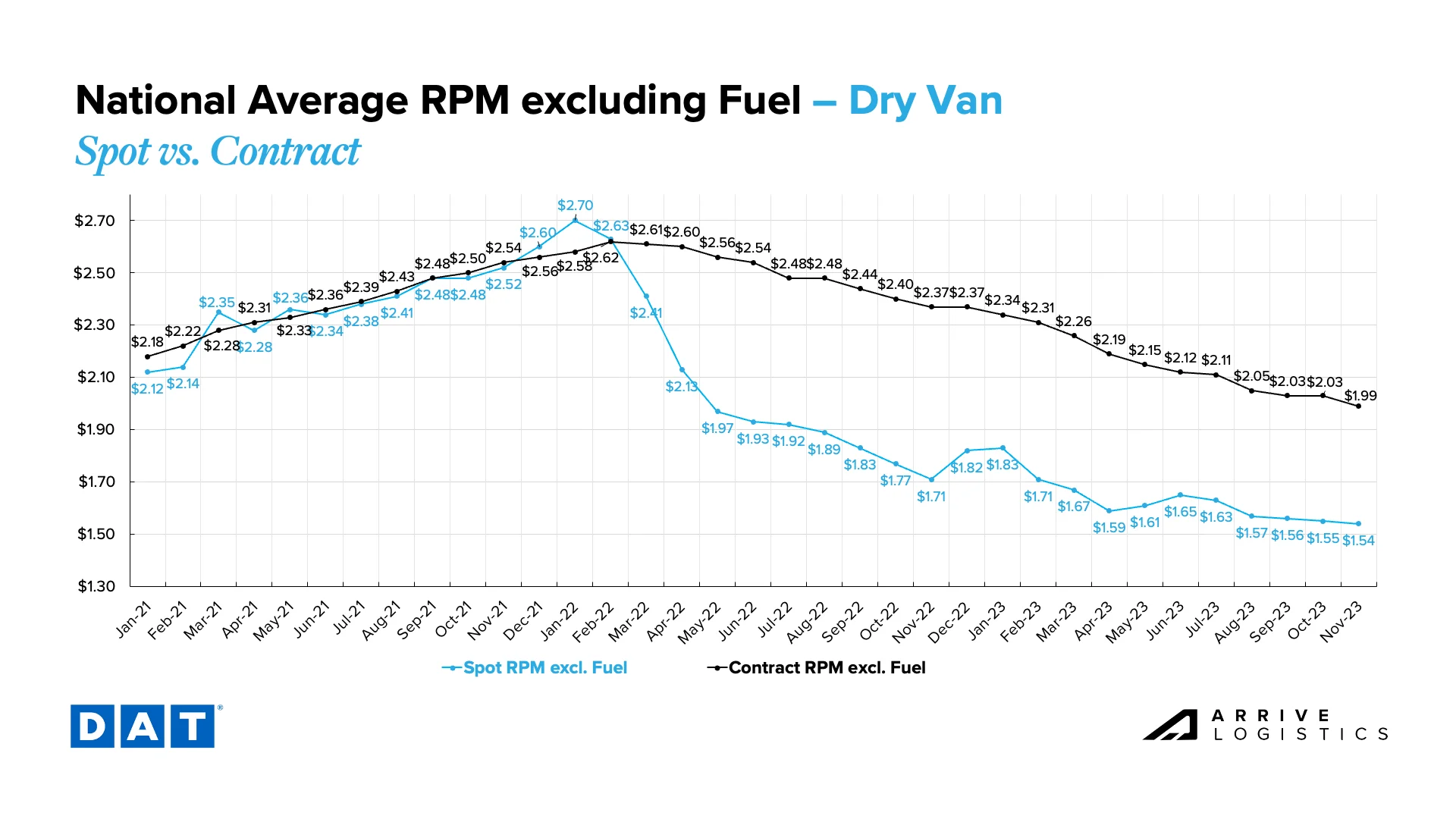
Monthly reefer rates are up in early November following four consecutive months of declines. After hitting a high of $0.58 in April, the reefer spot-contract rate spread has returned to year-to-date lows of $0.42 in early November due to the continued downward movement of contract rates and a seasonal spot rate spike. The current reefer contract rate is down 14.0% year-over-year to $2.32 per mile, excluding fuel, while the current reefer spot rate is down 11.5% year-over-year to $1.90 per mile, excluding fuel.
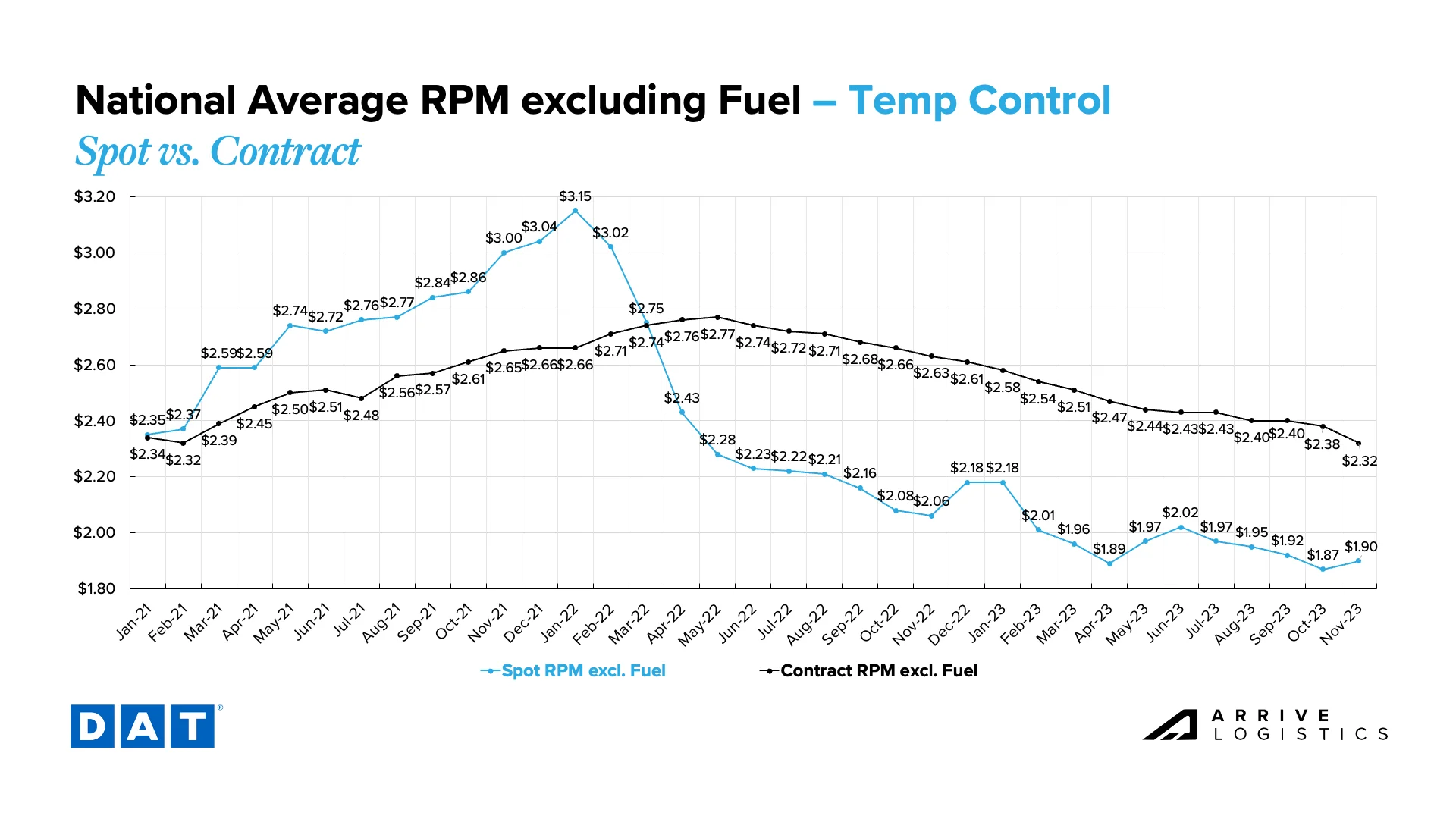
After stabilizing in the first half of 2023, flatbed rates declined rapidly from June through August and have since found a new floor. Contract rates fell similarly, keeping the spot-contract gap at $0.72 per mile after dipping to a cycle low of $0.58 in April. In November, spot rates are currently $1.83 and contract at $2.55 per mile, excluding fuel.
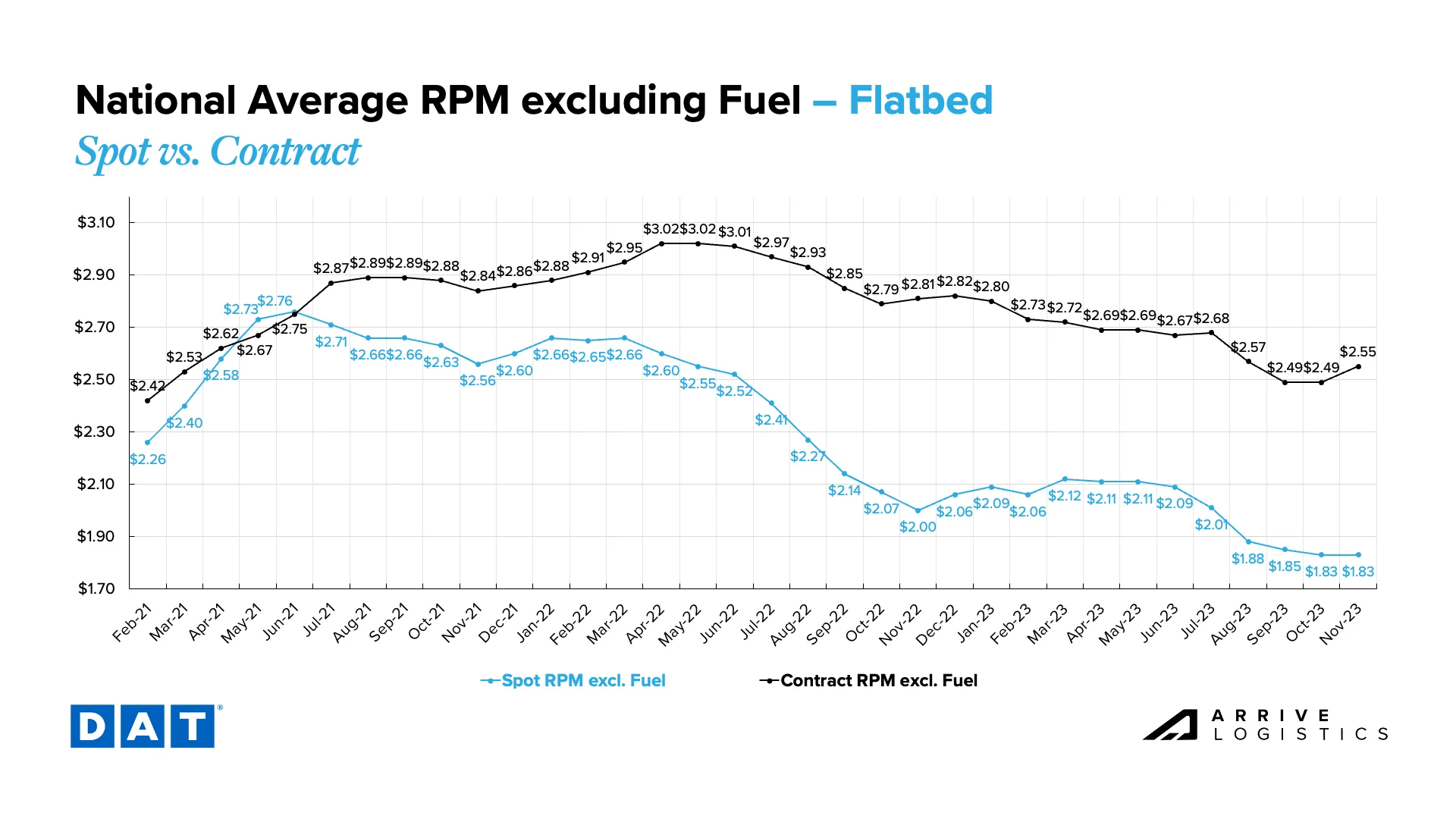
We also asked our carriers what their truckload rates are compared to one year ago. Unsurprisingly, 81% of respondents reported that rates are down year-over-year, while 14% and 5%, respectively, said that rates were flat or higher. This is what we expected, as rates have been in a steady decline for well over a year.
We also asked the same set of carriers what direction they thought rates would go over the next three months. Over half of respondents believe rates will decline throughout the rest of 2023, 21% said they will be flat, and 21% expect rates to rise. These results reflect collective uncertainty about current market conditions and whether we will experience a strong or muted holiday demand push.
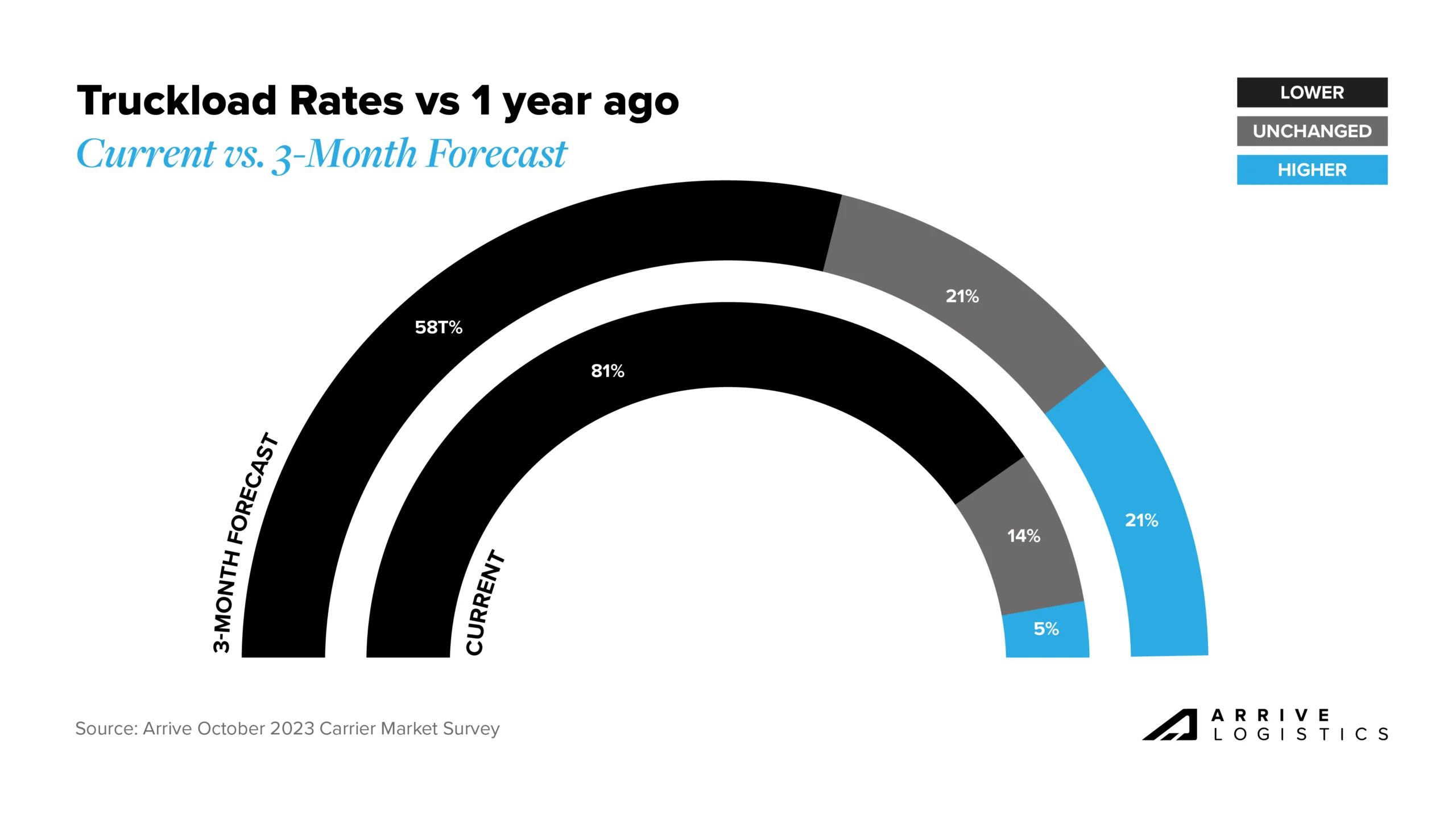
What’s Happening: Inflation is cooling but remains well above the target rate.
Why It Matters: The Fed is unlikely to reduce rates, meaning demand will remain flat or down in the upcoming months.
September CPI data showed that inflation will likely stay sticky even though price increases in October CPI data indicated cooling inflation due to lower price pressures on items such as gasoline and airfare. While this is a sign that the economy is moving in the right direction, it is unlikely that the Fed will lower interest rates during their final meeting this year.
The connection between elevated interest rates and slowing freight volumes is evident when looking at demand for manufacturing and housing commodities — two large sectors that contribute meaningfully to freight demand. With interest rates remaining at a 22-year high, investment in those sectors is declining, and freight demand is following suit. However, the Fed could lower interest rates sometime next year as inflation decreases, which would reignite economic activity and positively impact freight volumes.
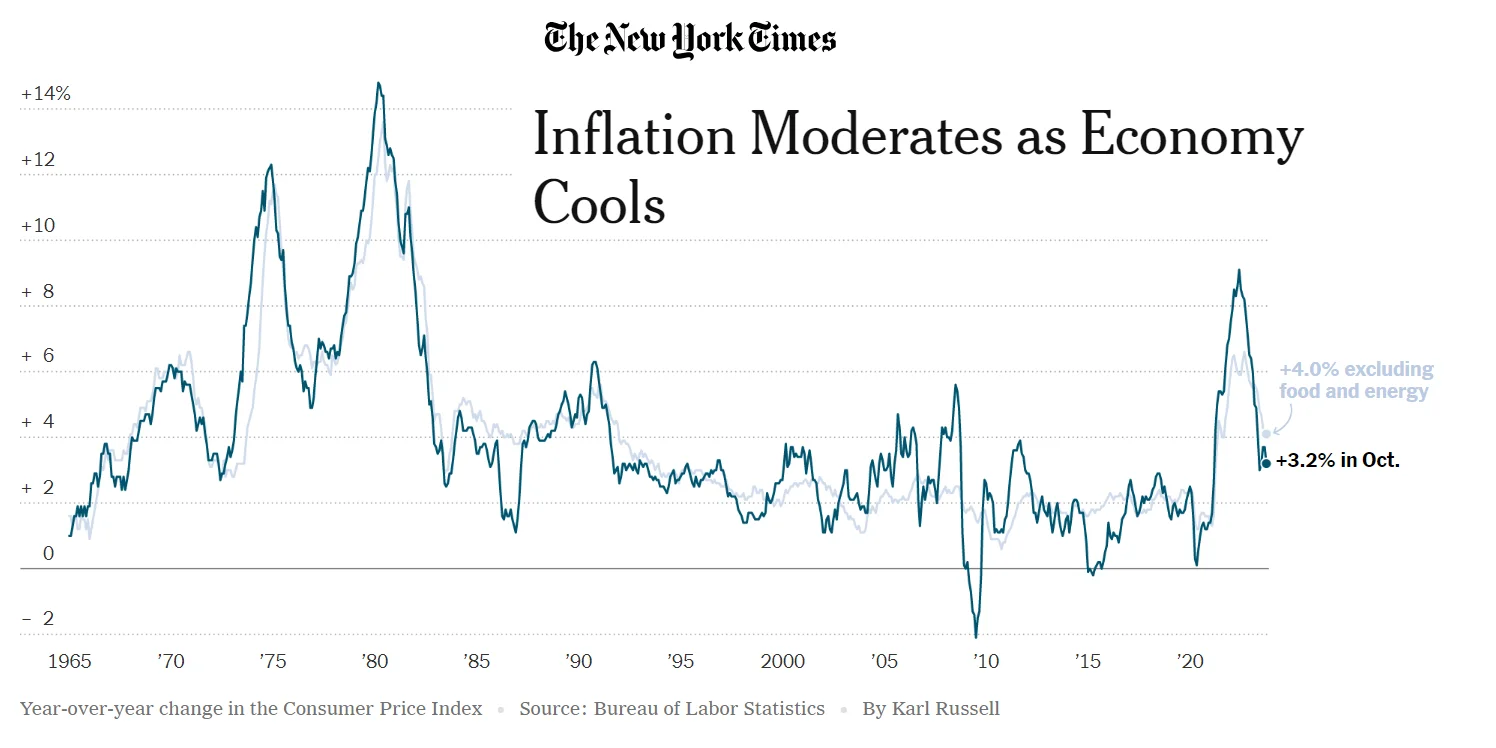
National diesel prices have declined steadily over the past month, following large increases during the second half of summer. The price increases can be attributed to historically high demand and production cuts by Saudi Arabia and other OPEC countries. As demand dwindled over the second half of September and into October, so did prices.
Geopolitical events impact fuel prices. Soon after Russia invaded Ukraine, fuel prices saw a historic spike that took several months to settle, which is why we are now monitoring the impact of rising tensions in the Middle East. While Israel and Palestine are not significant oil providers, the Middle East region directly impacts prices in the United States. If the conflict were to reach other areas in the Middle East, another large spike in fuel prices would likely result.
Figure 31: National Average Diesel Rates & DAT Fuel Surcharge RPM
The market is still relatively quiet as the holiday season begins. However, we have started to see some pockets of tightness as we approach Thanksgiving. Reefer rates are rising in the Pacific Northwest along with the Upper Midwest. Dry van and flatbed rates remain relatively stable, and the market still has more than enough capacity to support demand.
Due to high spot market exposure, small fleets and owner-operators are feeling the most pressure from current conditions. Many are closing or joining larger, more financially stable fleets. With plentiful capacity and low demand in the market, these conditions will likely continue for at least the near term.
While we expect some volatility during the holiday season, it will likely be muted compared to recent years. Economic uncertainty will make consumers more mindful of their spending and could result in lower Q4 demand. Spending growth has also declined, and as a result, we are seeing lower import volumes than expected, another indication that this holiday season will be quiet.
Inflation continues to cool but remains well above the Fed’s historical target of 2%. This means that the Fed is unlikely to reduce interest rates during their meeting in December. With interest rates at a 22-year high, we are unlikely to see any meaningful demand push until rates come down.
Our 2024 outlook is mostly unchanged. The spot-contract gap remains elevated, which should result in deflationary pressure on contract rates. However, current spot rate levels will not be sustainable for the long term, especially if fuel prices stay elevated and squeeze carrier profits. The market will become increasingly vulnerable to disruptive events as capacity normalizes throughout the first half of 2024, but we do not anticipate any significant disruptions in the short term.
The Arrive Carrier Market Outlook, created by Arrive Insights™, is a report that analyzes data from multiple sources, including but not limited to FreightWaves SONAR, DAT, FTR Transportation Intelligence, Morgan Stanley Research, Bank of America Internal Data, ACT Research, Journal of Commerce, Stephens Research, National Retail Federation and FRED Economic Data from the past month as well as year-over-year. We know market data is vital in making real-time business decisions. At Arrive Logistics, we are committed to giving you the data and insights you need to better manage your freight.

